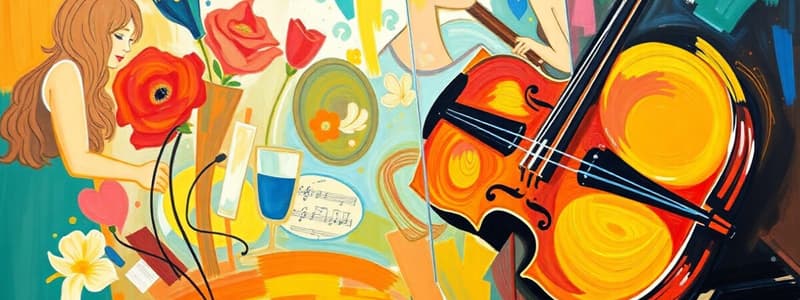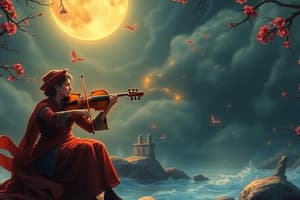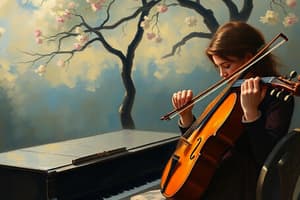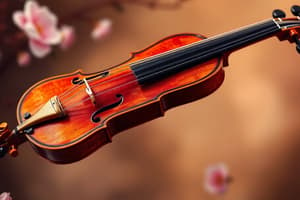Podcast
Questions and Answers
Which composer is recognized for incorporating nationalism through the use of folk tunes in their works?
Which composer is recognized for incorporating nationalism through the use of folk tunes in their works?
- Frederic Chopin (correct)
- Robert Alexander Schumann
- Niccolo Paganini
- Franz Liszt
What is the most notable accomplishment of Niccolo Paganini in the music world?
What is the most notable accomplishment of Niccolo Paganini in the music world?
- He invented a new style of piano music.
- He gained fame as a violin virtuoso. (correct)
- He collaborated with Fredric Chopin in compositions.
- He was the first to compose a symphonic poem.
Which term best describes the musical works of Franz Liszt that translate literary themes into music?
Which term best describes the musical works of Franz Liszt that translate literary themes into music?
- Symphonic Poems (correct)
- Concertos
- Nocturnes
- Sonatas
At what age did Frederic Chopin compose his first piece, the Polonaise?
At what age did Frederic Chopin compose his first piece, the Polonaise?
Which movement of Symphonie Fantastique is characterized by a slow introduction followed by an agitated allegro?
Which movement of Symphonie Fantastique is characterized by a slow introduction followed by an agitated allegro?
Which of the following works is NOT associated with Niccolo Paganini?
Which of the following works is NOT associated with Niccolo Paganini?
Which composer is best known for his program music that evokes images and tells a story without lyrics?
Which composer is best known for his program music that evokes images and tells a story without lyrics?
Which of the following works is NOT one of Camille Saint-Saens' famous compositions?
Which of the following works is NOT one of Camille Saint-Saens' famous compositions?
Which characteristic is commonly associated with Frederic Chopin's musical style?
Which characteristic is commonly associated with Frederic Chopin's musical style?
What form is used in the second movement of Symphonie Fantastique?
What form is used in the second movement of Symphonie Fantastique?
What role did Friedrich Wieck play in Robert Schumann's career?
What role did Friedrich Wieck play in Robert Schumann's career?
What is a key characteristic of the music composed by Camille Saint-Saens?
What is a key characteristic of the music composed by Camille Saint-Saens?
Which of these works is often considered one of the most popular pieces by Franz Liszt?
Which of these works is often considered one of the most popular pieces by Franz Liszt?
Which movement of Symphonie Fantastique includes a scene represented by a march leading to the scaffold?
Which movement of Symphonie Fantastique includes a scene represented by a march leading to the scaffold?
Which Russian composer was a fan of Mozart and known for his ballet music?
Which Russian composer was a fan of Mozart and known for his ballet music?
What is a defining feature of program symphonies?
What is a defining feature of program symphonies?
Flashcards
Program Music
Program Music
Instrumental music that tells a story without words, using musical elements to evoke images and emotions.
Program Symphony
Program Symphony
A symphony that tells a story or relays ideas using musical elements.
Tone Color
Tone Color
A composition that uses tone color (the sound of different instruments) as a primary element in creating its musical language.
Symphonie Fantastique
Symphonie Fantastique
Signup and view all the flashcards
Pyotr Ilyich Tchaikovsky
Pyotr Ilyich Tchaikovsky
Signup and view all the flashcards
Camille Saint-Saëns
Camille Saint-Saëns
Signup and view all the flashcards
Variations
Variations
Signup and view all the flashcards
Carnaval
Carnaval
Signup and view all the flashcards
Romantic Music
Romantic Music
Signup and view all the flashcards
Nationalism in Music
Nationalism in Music
Signup and view all the flashcards
Niccolo Paganini
Niccolo Paganini
Signup and view all the flashcards
Virtuoso
Virtuoso
Signup and view all the flashcards
Frederic Chopin
Frederic Chopin
Signup and view all the flashcards
Franz Liszt
Franz Liszt
Signup and view all the flashcards
Robert Schumann
Robert Schumann
Signup and view all the flashcards
Symphonic Poem
Symphonic Poem
Signup and view all the flashcards
Study Notes
Romantic Period Music
- Romantic music is Western music from the late 18th to the 19th century.
- Nationalism heavily influenced Romantic music, incorporating folk tunes, styles, and legendary figures.
- This style was prominent in Europe, particularly in Germany.
- Performance practice focused on how music was performed.
Violin and String Music
- Niccolò Paganini, an Italian virtuoso, was a highly skilled violinist.
- Became famous for his technique and compositions for solo violin.
- Famous works: La Campanella, Carnival of Venice, 24 Caprices for Solo Violin, Op. 1.
Piano Music
- Frédéric Chopin, known as the "Poet of the Piano," was a highly skilled pianist and composer.
- Started playing the piano at age 4 and composed by age 7.
- His music is known for beautiful tone, rhythmic flexibility, grace, and elegance.
- His works like mazurkas and polonaises express his Polish heritage.
- Famous works: Polonaise, Fantasie in F minor, Revolutionary Etude.
- Franz Liszt, a virtuoso pianist and composer, was influenced by Paganini.
- Known for his symphonic poems translating literary works into music.
- Also made piano transcriptions of operas and symphonies.
- Famous works: Hungarian Rhapsodies (popular including "Tom & Jerry's" "Cat Concerto"), Liebestraume No. 3.
- Robert Schumann, a composer and music critic, combined music and words.
- His father wanted him to study law but he pursued music. His teacher was Frederick Wieck.
- Famous works: Kinderszenen, Op. 15, Abegg Variations, Op. 1, Carnaval, Op. 9.
Program Music
- Program music is instrumental music that tells a story or evokes a scene.
- It enhances the listener's imagination through imagery.
- The music evokes specific emotional states.
- Hector Berlioz, a French composer, is known for his Symphonie Fantastique.
- This five-movement symphony uses tone color to convey a story.
- Berlioz used various musical elements within each movement to create and portray multiple emotional states and conditions throughout the story.
- Famous for his use of tone color.
- Sequence of Symphonie Fantastique:
- 1st Movement: Reveries/Passion – Largo, Allegro agitato e appassionato assai (agitated and very impassioned allegro).
- 2nd Movement: A Ball – Allegro non troppo (Waltz, ABA form).
- 3rd Movement: Scene in the Country – Adagio waltz (ABA Coda Form).
- 4th Movement: March to the Scaffold – Allegretto non troppo (Two themes).
- 5th Movement: Dream of a Witches' Sabbath – Larghetto allegro.
Other Composers
- Pyotr Ilyich Tchaikovsky, a Russian composer known for his ballets and symphonies.
- A fan of Mozart, he studied music at a conservatory and wrote works such as Fatum and Romeo and Juliet.
- Famous works: Swan Lake, The Nutcracker, Sleeping Beauty.
- Camille Saint-Saëns, a composer known for elegant and polished music.
- A skilled organist and pianist.
- Famous works: Carnival of the Animals, Danse Macabre, The Swan.
- Program symphony is an orchestral composition that portrays a story, ideas, or narrative. Examples include Don Quixote, Romeo and Juliet, and Fantastique Symphony.
Studying That Suits You
Use AI to generate personalized quizzes and flashcards to suit your learning preferences.




